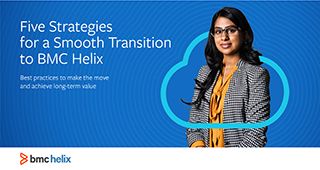Software as a Service (SaaS) is playing a central role in digital transformation as organizations set their sights on becoming Autonomous Digital Enterprises. SaaS enables organizations to replace costly and cumbersome legacy systems with pay-as-you-go services. The time to value with SaaS is markedly shorter and the implementation is far less costly because there’s no equipment to acquire, install, manage, maintain, and support. Additional benefits include enhanced agility in delivering innovation as well as value to the business and nearly limitless scalability.
SaaS isn’t about simply replacing one technology with another and then doing things the same way as in the past. You have to rethink, revamp, and even revolutionize to fully realize the value of the SaaS model. One critical aspect is the requirement for organizational change, which can be challenging and may be met with resistance.
This is the first of two blogs on the impact of SaaS on organizational change. It presents five critical success factors that help you navigate the change successfully. The second blog will describe the elements of an effective communication strategy that helps overcome pushback and gain the enthusiastic support of all stakeholders.
1. Obtain Executive-level Sponsorship
IT organizations have long recognized that the success of a technology initiative requires the wholehearted and visible support of one or more senior leaders. It’s important that these executive-level sponsors engage throughout the project and be available for problem solving when disagreements threaten to derail or delay the project.
For an initiative within a line of business (LOB) or department, you must have buy-in from the top—the chief marketing officer if you’re implementing a marketing automation solution, the chief information officer for an IT operations management or service management solution, or the vice president of human resources for an HRIS system. For an enterprise-wide initiative to implement a standard solution across LOBs and functional areas, you’ll need sponsorship from not only the executive leadership team, but also project sponsors from within the LOBs.
Ongoing support from sponsors keeps people moving in a common direction toward achieving top management’s vision.
2. Establish a Cross-discipline Center of Excellence
SaaS success requires close cooperation and collaboration among key stakeholders. Toward this objective, many enterprises are establishing cloud management teams, often called centers of excellence (CoEs), to bring the right people together to steer SaaS and cloud projects.
The CoE comprises people whose collective knowledge, skills, and job responsibilities can drive the success of the SaaS implementation. CoE members guide the planning and rollout, measure progress toward objectives, and tout successes to encourage adoption.
CoEs typically include the following types of people:
- The LOB/department app owner chairs meetings, manages costs, and tracks performance against objectives and expected outcomes.
- Central IT serves as a trusted advisor, performs integrations and customizations, and ensures compliance with the enterprise governance framework.
- Security people vet the app from a security standpoint and bring it under the enterprise security umbrella.
- Procurement personnel negotiate a favorable contract with the SaaS vendor.
- Corporate communications people apprise people of the organizational changes to come, along with timelines, benefits, progress, and successes.
- Finance people track costs and roll them up into total enterprise tech spend.
3. Identify and Communicate Organizational Changes
In the move from an on-premises system to SaaS, the vendor takes on responsibility for managing and maintaining the app and the underlying infrastructure. That takes a huge load off the IT staff, but to take full advantage of the resulting benefits requires some organizational changes.
Once you have established the high-level goals and objectives of the SaaS initiative, you need to seriously think through how the organization must change to ensure success. Some jobs will go away, but new jobs will be created. Determine what skills you’ll need, assess your current resources to identify gaps, and determine the best way to fill those gaps. One approach is to build internal expertise through training and recruitment. You can also look outside to bring in expertise, such as from your business partners. If you do engage outside help, be sure to develop plans to transfer knowledge to internal people.
Work closely with the employees who are likely to feel the biggest impact so you fully understand their capabilities and interests. Develop plans for training and education that will give them new skills and prepare them for new, more rewarding positions in the modern Autonomous Digital Enterprise.
You’ll need to develop a comprehensive communication plan to keep people aware and informed of progress throughout the SaaS journey. The plan should focus on the positive impact of the new solution and how it aligns with overall business goals. The second blog in this series will describe the elements of an effective communication plan.
4. Engage the User Community Early and Often
Executive-level sponsorship works from the top down, driving success through communication of clearly articulated objectives and unwavering support for marshalling resources behind those objectives. Engaging the user community, on the other hand, works from the bottom up, creating a groundswell that spreads across the enterprise and encourages broad adoption of the changes required to meet objectives. Engage users right from the beginning of the project.
Start by working with the app owner and users to understand their needs. Convey the reasons behind the change and how the change will benefit them. Develop two-way conversations that give users a voice in driving the change and foster a sense of ownership.
Tap the expertise of corporate communications to develop a plan that keeps users informed and in the loop. Larger SaaS vendors often provide materials and guidance in developing and managing a sound communication plan.
BMC clients have come up with a number of creative efforts that have generated user excitement and promoted adoption. One company created a user forum at the beginning of the project to capture the end-user perspective. Another customer conducted regular pop-up events throughout the planning and implementation phases to generate buzz and keep people informed on progress and successes.
5. Partner with Your SaaS Vendor
Your SaaS vendor has a huge stake in your success. Find out what services and tools the vendor offers to help you implement and manage the SaaS solution. Also, take advantage of the vendor’s technical expertise. For example, connect the vendor’s technicians with the people who are familiar with your internal systems to smooth integration with these systems.
Some vendors have a customer success team whose sole purpose is to help customers get the most from the SaaS solution. Take advantage of that team in both planning and implementing your SaaS solution.
The advantages of SaaS are many and include cost savings, greater agility in responding to your marketplace, and immediate scalability. But to fully realize these advantages, you need to embrace organizational change. By applying these five critical success factors you can gain both top-down and bottom-up support to propel you along a successful SaaS journey.
Five Strategies for a Smooth Transition to BMC Helix
These postings are my own and do not necessarily represent BMC's position, strategies, or opinion.
See an error or have a suggestion? Please let us know by emailing blogs@bmc.com.







